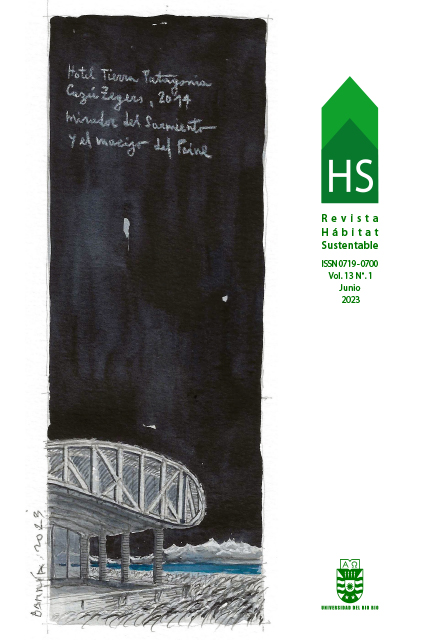Tapanco in vernacular houses in Querétaro, Mexico. Use and hygrothermal efficiency
DOI:
https://doi.org/10.22320/07190700.2023.13.01.09Keywords:
vernacular architecture, bioclimatic architecture, global warming, nergy efficiencyAbstract
Today, the climatic consequences caused by greenhouse gas (GHG) emissions are evident and are on track to see global warming of 2.7 °C by the end of the century. The energy dependence of buildings is one of the main causes, since they required 50% of global energy consumption in 2021 just for heating, making it necessary to implement passive bioclimatic air conditioning systems. This work documents the use in vernacular dwellings in Queretaro, Mexico, of an efficient attic-type passive system, called "tapanco", consisting of an inert air chamber that functions as a thermal buffer. A case was evaluated by applying measurement methodologies with thermo-hygrometers, complemented with thermography and thermo-wind simulation. The findings of adequate hygrometric indices, fostered by the system, make it a relevant alternative for a passive solution in future bioclimatic architectural design, to reduce adverse energy and climatic indices.
Downloads
References
AGUILERA, P., VIÑAS, C., RODRÍGUEZ, A. & VARELA, S. (2018). Análisis de la influencia, en la demanda de climatización, de estrategias pasivas en viviendas con grandes superficies acristaladas, mediante un código de simulación. La casa Farnsworth. Anales de Edificación, 4(3), 34-43 DOI: https://doi.org/10.20868/ade.2018.3798
ALAMINO NARANJO, Y. & KUCHEN, E. (2021). Indicadores para evaluar el rendimiento de usuarios de oficina en clima templado cálido. Informes de la Construcción, 73(564), e420. DOI: https://doi.org/10.3989/ic.83476
CALDERON, F. (2019). Evaluación del mejoramiento del confort térmico con la incorporación de materiales sostenibles en viviendas de autoconstrucción en Bogotá, Colombia. Hábitat Sustentable, 9(2), 30–41. DOI: https://doi.org/10.22320/07190700.2019.09.02.03
CEJA, F. (2012). Evaluación de prototipos de vivienda sustentable y de bajo costo. [Tesis de maestría, Centro de Investigación y Desarrollo Tecnológico en Electroquímica de Querétaro (CIDETEQ)].
FERNANDEZ, A., GARZÓN, B. & ELSINGER, D. (2020). Incidencia de las estrategias pasivas de diseño arquitectónico en la etiqueta de eficiencia energética en Argentina. Hábitat Sustentable, 10(1), 56–67. DOI: https://doi.org/10.22320/07190700.2020.10.01.05
GANEM-KARLEN, C. (2018). Termografía infrarroja para el diagnóstico térmico confiable con alta replicabilidad y bajo costo de viviendas en Mendoza, Argentina. Hábitat Sustentable, 8(2), 80–89. DOI: https://doi.org/10.22320/07190700.2018.08.02.06
Global Crisis Response Group. (2022). Global impact of war in Ukraine: Energy Crisis. Brief No. 3. Recuperado de: https://unsdg.un.org/sites/default/files/2022-08/GCRG_3rd-Brief_Aug3_2022_.pdf
HERRERA RIVAS, F. B. & MEDINA MÁRQUEZ, M. G. (2018). La cultura, continuidad y transmisión. Del territorio a la vivienda vernácula. En: DINÁMICAS URBANAS Y PERSPECTIVAS REGIONALES DE LOS ESTUDIOS CULTURALES Y DE GÉNERO. Universidad Nacional Autónoma de México, Instituto de Investigaciones Económicas, México. Recuperado de: http://ru.iiec.unam.mx/4417/1/3-101-Herrera-Medina.pdf
Instituto Nacional de Estadística y Geografía (2017). Anuario estadístico y geográfico de Querétaro 2017. Recuperado de: https://www.inegi.org.mx/contenidos/productos/prod_serv/contenidos/espanol/bvinegi/productos/nueva_estruc/anuarios_2017/702825092108.pdf
Intergovernmental Panel on Climate Change. (2022). Climate Change 2022. Mitigation of Climate Change. Recuperado de: https://www.ipcc.ch/report/ar6/wg3/downloads/report/IPCC_AR6_WGIII_FullReport.pdf
JUÁREZ, J. (2022). De la vivienda tradicional, a la vivienda popular rural en el centro occidente del estado de Puebla, México. Revista INVI, 37(106), 262-283. DOI: https://doi.org/10.5354/0718-8358.2022.66515
LÁRRAGA, R., AGUILAR, M., REYES, H. & FORTANELLI, J. (2014). La sostenibilidad de la vivienda tradicional: una revisión del estado de la cuestión en el mundo. Revista de Arquitectura, 16(1), 126-133. DOI: https://doi.org/10.14718/RevArq.2014.16.14
MANDRINI, M. (2022). Sustentabilidad, confort térmico y arquitectura vernácula en políticas habitacionales rurales. Caso noroeste cordobés, Argentina. AUS [Arquitectura / Urbanismo / Sustentabilidad], (32), 4–11. DOI: https://doi.org/10.4206/aus.2022.n32-02
MARTÍN-CONSUEGRA, F., OTEIZA, I., ALONSO, C., CUERDO-VILCHES, T. & FRUTOS, B. (2014). Análisis y propuesta de mejoras para la eficiencia energética del edificio principal del Instituto c.c. Eduardo Torroja-CSIC. Informes de la Construcción, 66(536), e043. DOI: https://doi.org/10.3989/ic.14.125
MERCADO, M., BAREA-PACI, G., ESTEVES, A. & FILIPPÍN, C. (2018). Efecto de la ventilación natural en el consumo energético de un edificio bioclimático. Análisis y estudio mediante energy plus. Hábitat Sustentable, 8(1), 54–67. DOI: https://doi.org/10.22320/07190700.2018.08.01.05
OLGYAY, V. (1998). Arquitectura y Clima. Manual de Diseño Bioclimático para Arquitectos y Urbanistas. Gustavo Gili S.A.
RAPOPORT, A. (2003). Cultura, Arquitectura y Diseño. UPC Editions.
REUS-NETTO, G., MERCADER-MOYANO, P. & CZAJKOWSKI, J. (2019). Methodological Approach for the Development of a Simplified Residential Building Energy Estimation in Temperate Climate. Sustainability, 11(15), 4040. DOI: https://doi.org/10.3390/su11154040
RINCÓN-MARTÍNEZ, J. C., GARCÍA-GÓMEZ, C. & GONZÁLEZ-TREVIZO, M. (2022). Estimación del rango de confort higrotérmico para exteriores en dos bioclimas extremos de México. Ingeniería Investigación y Tecnología, 23(02), 1-14. DOI: https://doi.org/10.22201/fi.25940732e.2022.23.2.014
SUÁREZ, R., ESCANDÓN, R., LÓPEZ-PÉREZ, R., LEON-RODRIGUEZ, A., KLEIN, T. & SILVESTER, S. (2018). Impact of Climate Change: Environmental Assessment of Passive Solutions in a Single-Family Home in Southern Spain. Sustainability, 10(8), 2914. DOI: https://doi.org/10.3390/su10082914
United Nations Environment Programme. (2021). Emissions Gap Report 2021: The Heat Is On – A World of Climate Promises Not Yet Delivered. Nairobi. Recuperado de: https://www.unep.org/es/resources/emissions-gap-report-2021
Downloads
Published
How to Cite
Issue
Section
License
Copyright (c) 2023 Martin Hernandez-Chavela, Flavio Roberto Ceja-Soto, Ángel Marroquín de Jesús

This work is licensed under a Creative Commons Attribution-ShareAlike 4.0 International License.
The content of articles which are published in each edition of Habitat Sustentable, is the exclusive responsibility of the author(s) and does not necessarily represent the thinking or compromise the opinion of University of the Bio-Bio.
The author(s) conserve their copyright and guarantee to the journal, the right of first publication of their work. This will simultaneously be subject to the Creative Commons Recognition License CC BY-SA, which allows others to share-copy, transform or create new materials from this work for non-commercial purposes, as long as they recognize authorship and the first publication in this journal, and its new creations are under a license with the same terms.











 Scientific Information Program/Concurso Fondos de Publicación de Revistas Científicas 2018/ Proyecto Mejoramiento de Visibilidad de Revistas UBB (Código:FP180007).
Scientific Information Program/Concurso Fondos de Publicación de Revistas Científicas 2018/ Proyecto Mejoramiento de Visibilidad de Revistas UBB (Código:FP180007).





